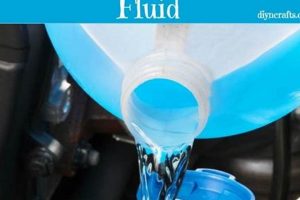A preparation crafted at home for cleansing the facial skin offers a customizable approach to skincare. For instance, individuals may combine ingredients such as honey, oils, and essential oils to create a personalized skin cleanser, addressing specific skin concerns.
The practice presents several advantages, including control over ingredients and a potential reduction in exposure to synthetic chemicals commonly found in commercially manufactured cleansers. Historically, homemade beauty remedies were prevalent, offering a natural alternative to mass-produced products.
Subsequent sections will delve into specific recipes, ingredient selection criteria, storage recommendations, and potential safety considerations when formulating cleansing solutions at home.
Formulating Cleansing Solutions
The following guidelines aim to ensure both efficacy and safety when creating facial cleansers at home.
Tip 1: Prioritize Ingredient Quality: Opt for organic, unrefined ingredients whenever possible. This minimizes exposure to pesticides and other potential irritants.
Tip 2: Patch Test New Formulas: Before applying any homemade cleanser to the entire face, conduct a patch test on a small, discreet area, such as the inner arm, to assess for allergic reactions or sensitivities.
Tip 3: Understand Ingredient Properties: Research the specific benefits and potential risks associated with each ingredient. Certain essential oils, for instance, may be phototoxic and should be avoided before sun exposure.
Tip 4: Maintain Hygiene: Thoroughly clean and sterilize all equipment and containers used in the preparation process. This minimizes the risk of bacterial contamination.
Tip 5: Adjust Formulas Gradually: When modifying a recipe, introduce changes one at a time to better identify the cause of any adverse reactions.
Tip 6: Consider Skin Type: Adapt formulations based on individual skin characteristics. Drier skin may benefit from more emollient ingredients, while oilier skin may require lighter, astringent components.
Tip 7: Proper Storage is Crucial: Store prepared cleansers in airtight, opaque containers in a cool, dark location to prevent degradation and maintain product integrity.
Tip 8: Shelf Life Awareness: Homemade solutions typically lack preservatives found in commercial products. Be mindful of the limited shelf life and discard any cleanser showing signs of spoilage.
Adherence to these tips promotes a safer and more effective experience when creating custom facial cleansers.
The subsequent discussion will address specific ingredient profiles relevant to various skin conditions.
1. Ingredient Selection
Ingredient selection represents a critical determinant of the efficacy and safety of any homemade facial cleanser. The chosen components directly impact the cleanser’s ability to remove impurities, maintain skin hydration, and address specific dermatological concerns. A mismatch between ingredients and skin type can lead to adverse reactions, such as irritation, dryness, or breakouts. For example, individuals with sensitive skin may experience redness or inflammation if a cleanser contains harsh surfactants or potent essential oils. Conversely, those with oily skin might find that cleansers formulated with heavy oils contribute to clogged pores and increased sebum production.
The inherent properties of each ingredient contribute uniquely to the final product. Honey, for instance, functions as a humectant, drawing moisture into the skin, while also possessing antibacterial properties. Clay, such as bentonite or kaolin, can absorb excess oil and impurities. The selection process necessitates a thorough understanding of these properties and their potential interactions. Real-world examples include individuals utilizing aloe vera for its soothing and anti-inflammatory effects on irritated skin or incorporating tea tree oil for its antimicrobial benefits in addressing acne. Careful ingredient evaluation prevents potential skin damage and optimizes cleansing performance.
In summary, discerning ingredient selection forms a cornerstone of successful facial cleanser creation. Prioritizing compatibility with individual skin needs and understanding the unique attributes of each component yields significant benefits. This careful approach minimizes the risk of adverse reactions while maximizing the potential for a gentle and effective cleansing experience. The challenge lies in continuous learning about new ingredients and adapting formulations to changing skin conditions.
2. Skin Type
The classification of skin type, encompassing categories such as oily, dry, combination, sensitive, and normal, serves as a fundamental consideration in the formulation of facial cleansing preparations. Skin type dictates the selection of ingredients and the overall composition of the cleansing solution. For instance, the use of oil-based cleansers on oily skin can exacerbate sebum production, leading to clogged pores and potential acne breakouts. Conversely, water-based cleansers may prove insufficient for removing oil-soluble impurities from oily skin, resulting in inadequate cleansing. Individuals with dry skin often benefit from formulations containing moisturizing oils and humectants to combat dehydration and maintain skin barrier function. A mismatch between skin type and cleanser formulation can compromise the skin’s natural balance, causing irritation, dryness, or increased sensitivity. Therefore, accurate identification of skin type is paramount to achieving optimal cleansing results.
In practice, this understanding translates into specific ingredient choices. For dry skin, ingredients such as shea butter, avocado oil, and hyaluronic acid are frequently incorporated into facial cleansers to provide emollient and humectant properties. Individuals with oily skin may opt for formulations containing tea tree oil, witch hazel, or salicylic acid to control sebum production and exfoliate dead skin cells. Combination skin often requires a balanced approach, utilizing ingredients that cleanse effectively without stripping the skin of its natural oils. Those with sensitive skin must exercise caution, selecting hypoallergenic and fragrance-free ingredients to minimize the risk of irritation. Real-world examples illustrate the practical significance of skin type consideration, with individuals reporting improvements in skin health and appearance upon tailoring their cleansing routine to their specific skin needs.
In conclusion, skin type stands as a crucial determinant in the selection and formulation of effective facial cleansers. An informed approach, taking into account individual skin characteristics, promotes skin health and minimizes the potential for adverse reactions. However, the dynamic nature of skin, influenced by factors such as age, environment, and hormonal changes, necessitates ongoing evaluation
and adaptation of cleansing routines. The challenge lies in maintaining a holistic perspective, recognizing that skin care is an evolving process requiring continuous learning and refinement.
3. Formulation Stability
The longevity and effectiveness of facial cleansing preparations created at home are significantly influenced by formulation stability. The inherent instability of certain natural ingredients, coupled with the absence of synthetic preservatives commonly found in commercial products, presents unique challenges in maintaining product integrity.
- Oxidation of Oils
Unsaturated fatty acids present in many oils used in formulations are susceptible to oxidation, a process accelerated by exposure to light, heat, and air. This leads to rancidity, altering the scent and potentially causing skin irritation. Proper storage in opaque, airtight containers and the inclusion of antioxidants, such as vitamin E, can mitigate this degradation.
- Microbial Growth
The water content in preparations provides an environment conducive to microbial proliferation. Without appropriate preservatives, bacteria, mold, and yeast can contaminate the product, posing a health risk. Implementation of strict hygiene practices during preparation and storage in a cool, dry environment can reduce this risk.
- Emulsion Separation
When combining oil and water-based ingredients, an emulsion is formed. Without proper emulsifiers, this mixture can separate over time, affecting the product’s texture and efficacy. Selection of appropriate emulsifying agents and proper mixing techniques contribute to emulsion stability.
- Ingredient Interactions
Certain ingredients can react with each other, leading to changes in color, viscosity, or pH. This may compromise the product’s intended function and potentially cause skin irritation. Thorough research into ingredient compatibility is essential before formulation.
The aforementioned factors collectively influence the shelf life and overall utility of homemade facial cleansing products. Understanding these potential instabilities allows for informed decisions regarding ingredient selection, formulation techniques, and storage practices, ultimately enhancing the user experience.
4. Contamination Prevention
The potential for microbial contamination represents a significant concern in the context of facial cleansers formulated at home. Due to the absence of robust preservation systems typically found in commercially manufactured products, these homemade formulations are inherently more susceptible to bacterial, fungal, and yeast proliferation. Such contamination can compromise product efficacy and, more seriously, pose risks to dermatological health.
- Sterilization of Equipment
The use of unsterilized or improperly cleaned mixing bowls, utensils, and storage containers introduces microorganisms into the final product. Effective mitigation strategies include washing all equipment with hot, soapy water followed by sterilization via boiling, autoclaving (if available), or the use of a sanitizing solution. This minimizes the initial microbial load within the formulation.
- Water Quality
Tap water frequently harbors bacteria and other contaminants. Utilizing distilled or sterile water in the formulation process significantly reduces the risk of introducing these organisms. This is particularly important for water-based cleansers or those incorporating water as a key ingredient.
- Ingredient Handling
The introduction of microorganisms can occur through improper handling of raw materials. Utilizing clean hands and dispensing ingredients with sterile implements prevents cross-contamination. Bulk ingredients should be stored properly to prevent spoilage and microbial growth.
- Storage Conditions
Improper storage contributes to microbial proliferation. Prepared cleansers should be stored in airtight, opaque containers in a cool, dark location to inhibit microbial growth and prevent degradation of active ingredients. Exposure to direct sunlight and elevated temperatures accelerates microbial activity.
Stringent adherence to these contamination prevention measures is crucial in minimizing the risk of adverse reactions and ensuring the safety of homemade facial cleansing preparations. Failure to implement adequate preventative measures may result in skin irritation, infection, or other dermatological complications. Consequently, a thorough understanding and rigorous application of these principles are paramount.
5. Proper Application
The efficacy of any homemade facial cleansing preparation, while dependent on ingredient selection and formulation, is intrinsically linked to proper application techniques. Incorrect application methods can diminish the cleanser’s effectiveness and potentially induce adverse skin reactions. The cause-and-effect relationship is evident: gentle, circular motions facilitate the removal of dirt and debris, while aggressive scrubbing can lead to irritation. Proper application, therefore, serves as a crucial component of a successful at-home facial cleansing regimen. For instance, neglecting to thoroughly rinse the cleanser can leave residue that clogs pores, negating the intended benefit. Real-life examples often involve individuals experiencing increased dryness or breakouts despite utilizing well-formulated cleansers, attributable solely to improper application practices.
Practical application extends beyond simple washing motions. Water temperature plays a role; excessively hot water can strip the skin of natural oils, while cold water may not effectively remove impurities. The duration of application is also a factor; insufficient contact time may not allow the cleanser to adequately dissolve dirt and oil. The inclusion of a soft washcloth or facial brush can enhance cleansing but requires gentle use to avoid abrasion. Attention to these details optimizes the cleansing process and mitigates potential harm. Furthermore, knowledge of specific skin conditions, such as acne or rosacea, influences application techniques, necessitating even gentler approaches and avoidance of harsh scrubbing.
In summary, proper application forms an indispensable element in achieving optimal results with facial cleansers created at home. Neglecting this aspect undermines the benefits of even the most carefully formulated preparations. By understanding the nuances of application techniques, individuals can enhance the efficacy of cleansing, minimize the risk of adverse reactions, and promote healthier skin. The challenge lies in consistently applying these practices and adapting them to individual skin needs and conditions, emphasizing the holistic nature of skincare.
6. Realistic Expectations
The pursuit of homemade facial clea
nsing solutions necessitates a clear understanding of the limitations inherent in such endeavors. Without this understanding, individuals may experience frustration or dissatisfaction despite diligent efforts. Maintaining realistic expectations forms a crucial element of a successful experience.
- Limited Shelf Life
Homemade formulations, devoid of synthetic preservatives, exhibit a significantly shorter shelf life compared to commercially manufactured products. Expect deterioration in texture, scent, and efficacy within a few weeks. Regular monitoring and discarding products exhibiting signs of spoilage are essential. For instance, a homemade cleanser containing fresh fruit may develop mold within a few days, rendering it unusable.
- Variable Texture and Consistency
Achieving the smooth, consistent texture found in commercial cleansers presents a challenge. Variations in ingredient quality, mixing techniques, and environmental factors can result in a product that is grainy, lumpy, or prone to separation. A homemade cleanser employing natural oils, for example, may solidify at lower temperatures, requiring warming before use.
- Reduced Foaming Action
The absence of synthetic surfactants often results in a diminished foaming effect. While foaming action is not necessarily indicative of cleansing efficacy, individuals accustomed to commercial cleansers may perceive a lack of cleaning power. For example, a honey-based cleanser will not produce the abundant lather typical of a commercial sulfate-based cleanser.
- Potential for Allergies and Sensitivities
Natural ingredients, while often perceived as gentler, can trigger allergic reactions or sensitivities in some individuals. A patch test prior to widespread use is critical, and a gradual introduction of new ingredients is recommended. For instance, an individual may develop an allergic reaction to lavender essential oil, manifesting as redness, itching, or irritation.
These facets, collectively, highlight the importance of tempering expectations when engaging in the creation of homemade facial cleansing solutions. While control over ingredients and the potential for customization represent compelling advantages, acknowledging the limitations and inherent variability is paramount to a satisfactory and safe experience.
Frequently Asked Questions
The following addresses common inquiries regarding homemade facial cleansing solutions, providing concise and authoritative responses.
Question 1: Are homemade facial cleansers inherently superior to commercial products?
The purported superiority of a homemade cleanser is contingent upon ingredient selection, formulation, and individual skin characteristics. While homemade solutions offer control over ingredients, commercial products often incorporate advanced formulations and rigorous quality control measures.
Question 2: What is the typical shelf life of facial cleansers created at home?
Shelf life is contingent upon the ingredients used and storage conditions. Generally, homemade cleansers lack synthetic preservatives and exhibit a shorter shelf life, typically ranging from one to four weeks. Refrigeration may extend this duration; however, visual inspection for signs of spoilage is critical.
Question 3: How can the risk of allergic reactions be minimized?
A patch test is essential prior to widespread use. Applying a small amount of the cleanser to a discreet area of skin, such as the inner arm, allows for the observation of any adverse reactions over a 24 to 48-hour period. Introduction of new ingredients should be gradual and methodical.
Question 4: Is it possible to formulate an effective cleanser without synthetic ingredients?
Synthetic ingredients are not a prerequisite for effective cleansing. Many natural ingredients, such as oils, clays, and honey, possess inherent cleansing properties. However, the absence of synthetic surfactants may result in a less pronounced foaming action.
Question 5: Can homemade facial cleansers address specific dermatological conditions?
Certain ingredients, such as tea tree oil for acne or chamomile for inflammation, possess properties that may benefit specific conditions. However, homemade cleansers should not be considered a substitute for professional medical treatment. Consultation with a dermatologist is advisable.
Question 6: What are the key considerations for maintaining hygiene during the formulation process?
Thorough sterilization of equipment, utilization of distilled water, and proper storage practices are paramount. All mixing bowls, utensils, and storage containers should be sterilized prior to use. Hands should be washed thoroughly, and the final product should be stored in an airtight container in a cool, dark location.
Homemade facial cleansers offer potential benefits; however, a comprehensive understanding of formulation, safety, and limitations is essential for achieving optimal results.
Subsequent discussions will delve into advanced formulation techniques and troubleshooting common issues.
Conclusion
The preceding analysis has presented an in-depth examination of diy face wash, encompassing aspects from ingredient selection and formulation stability to application techniques and realistic expectation management. Emphasis has been placed on understanding both the advantages and limitations inherent in creating cleansing solutions at home, underscoring the importance of informed decision-making.
As individuals consider embarking on this path, rigorous adherence to safety protocols, continuous learning, and adaptation to individual skin needs remain paramount. The integration of this knowledge fosters a safer and more efficacious approach to personalized skincare, contributing to enhanced dermatological well-being.







